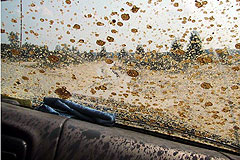Poor visibility is the cause of many wintertime accidents. Here are few tips on how to Better assure you can see and be seen during the more limited visibility conditions that come with winter. Also, there are couple of things to increase the chances that you windshield will make it through the winter without damage.

Inspect your windshield wiper blades are in good condition and are able to completely clear the windshield in no more than three complete cycles. If not, or they are obviously damaged, replace them. If possible, do your inspection and replacements on a nice day, which is much more preferable than doing it on a cold, snowy night. If you live in areas with severe winter conditions, install winter-type blades that are more capable of removing snow and ice without becoming clogged with snow and ice.
Invest in two sets of snow brushes and ice scrapers. Then keep one set at home and the other in the vehicle. This will let you remove snow and ice before you open the door so snow doesn’t fall inside. Don’t forget to bring one set inside so it will be ready for the next use. Also keep window and lock deicers in your home. They won’t do much good locked in a frozen vehicle. You might also carry deicers in the vehicle. Also use scrapers and brushes rather than metallic items like keys and coins that can damage windshields with deep scratches, In a pinch, a credit card can used as a windshield-friendly scraper.
Don’t forget your windshield washer fluid. Check the reservoir frequently to make sure it Is always filled. Use washer fluid rather than water that can freeze. Finding that you are out of fluid when your windshield is covered with dirty and salty slush is not only frustrating, but dangerous if it distorts vision. It can also scratch your windshield when the gritty stuff is moved back and forth by the wiper blades. Use your defroster to keep the windshield warm and keep moisture from freezing on the windshield in extreme cold.
To assure to can be seen by other drivers, make sure all you lights - headlights, brake lights and turn signals are all in good working condition. Again, it is more pleasant to check out lighting on a warm, sunny day, and definitely better to check before being pulled over by the police for an inoperable light. Also clean the lenses on all lights so they are most effective.
Then keep the clean including removing snow from lights before driving.
Finally, completely clear all windows of ice and snow before driving off. Don’t try to drive With only a few “peep” holes for visibility. Good visibility is even more important in winter with overcast skies, longer hours of darkness and with other drivers having reduced control of their vehicles on icy roads.
Winter can be tough on windshields. Small rocks thrown up by other vehicles and rock salt dispensed by snow plows can chip windshields. Thus, keep your distance behind snowplows.
Sudden temperature changes can cause cracked windshields. Therefore, never pour hot or boiling water onto a cold windshield to melt ice. Auto glass cannot withstand such a sudden temperature change and may crack.
ILLUSTRATION: A truck just splashed you. And now you find that you are out of washer fluid - don’t let this happen to you. Keep the reservoir topped off.




